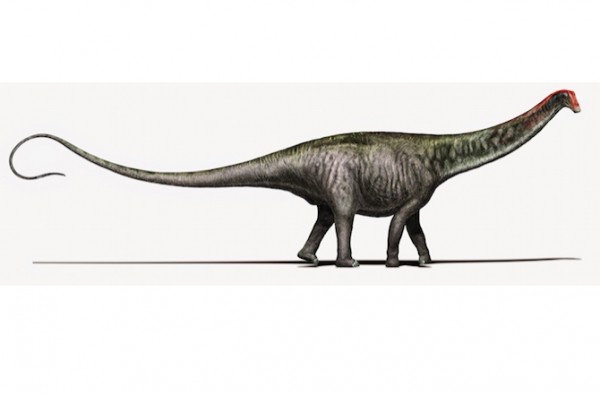Brontosaurus Dinosaur Name Makes a Comeback
| Marco Foronda | | Apr 07, 2015 08:52 AM EDT |
(Photo : Davide Bonadonna, Milan, Italy. Creative commons license CC- BY NC SA.) Shown is what researchers now believe Brontosaurus would have looked like.
One of the most iconic dinosaurs, Brontosaurus, is back on its own in the dino history books, having regained its status as a unique genus and species.
Paleontologists have spent the last century insisting the species and its name are invalid-that the first fossil was incorrectly or deceptively described, or what was called Brontosaurus is really another similar dinosaur, the Apatosaurus.
Like Us on Facebook
The reclassification appears to resolve a long-standing debate over what to do with Brontosaurus, which looked a lot like Apatosaurus.
That similarity had caused paleontologists to rename Brontosaurus as Apatosaurus excelsus. In short, it was just considered to be another type of Apatosaurus. Gone was the cool name Brontosaurus, which means "thunder lizard" in Greek.
The fossils show enough skeletal differences from other specimens of Apatosaurus that they rightfully belong to a different genus.
There are seven specific bone differences that make the body of the original Brontosaurus its own species and genus, according to Emanuel Tschopp at the New University of Lisbon in Portugal.
Most of them are rather subtle. The tail vertebrae in dinosaurs related to Brontosaurus have spiny prominences called neural spines. These dinosaurs' spines project kind of backwards, but in Brontosaurus they're straighter up.
Brontosaurus's hips are unusual, with two bones (the ilium and pubis) meeting a curious junction. Its lower leg fibula meets its ankle bones in an equally unusual manner.
Tschopp examined bones in 18 different museums in the United States and Europe and studied photos and drawings from other specimens. The idea was to get a high-resolution family tree by examining many individual specimens, rather than focusing only on fossils that represent an entire species.
The study included six specimens of Apatosaurus excelsus, as Brontosaurus has been called since 1903.
"The differences we found between Brontosaurus and Apatosaurus were at least as numerous as the ones between other closely related genera, and much more than what you normally find between species," explained Roger Benson from the University of Oxford.
Brontosaurus has also undergone a minor image makeover as a result of the study. Because of its evolutionary history, the researchers believe the dinosaur probably had a head similar to that of Diplodocus.
The study appeared in the journal PeerJ.
TagsBrontosaurus Dinosaur Name Make a Come Back, Brontosaurus, Apatosaurus, Dinosaur era, ancient animal, dinosaur fossil, animal fossil
©2015 Chinatopix All rights reserved. Do not reproduce without permission
EDITOR'S PICKS
-

Did the Trump administration just announce plans for a trade war with ‘hostile’ China and Russia?
-

US Senate passes Taiwan travel bill slammed by China
-

As Yan Sihong’s family grieves, here are other Chinese students who went missing abroad. Some have never been found
-

Beijing blasts Western critics who ‘smear China’ with the term sharp power
-

China Envoy Seeks to Defuse Tensions With U.S. as a Trade War Brews
-

Singapore's Deputy PM Provides Bitcoin Vote of Confidence Amid China's Blanket Bans
-

China warns investors over risks in overseas virtual currency trading
-

Chinese government most trustworthy: survey
-

Kashima Antlers On Course For Back-To-Back Titles
MOST POPULAR
LATEST NEWS
Zhou Yongkang: China's Former Security Chief Sentenced to Life in Prison

China's former Chief of the Ministry of Public Security, Zhou Yongkang, has been given a life sentence after he was found guilty of abusing his office, bribery and deliberately ... Full Article
TRENDING STORY

China Pork Prices Expected to Stabilize As The Supplies Recover

Elephone P9000 Smartphone is now on Sale on Amazon India

There's a Big Chance Cliffhangers Won't Still Be Resolved When Grey's Anatomy Season 13 Returns

Supreme Court Ruled on Samsung vs Apple Dispute for Patent Infringement

Microsoft Surface Pro 5 Rumors and Release Date: What is the Latest?










